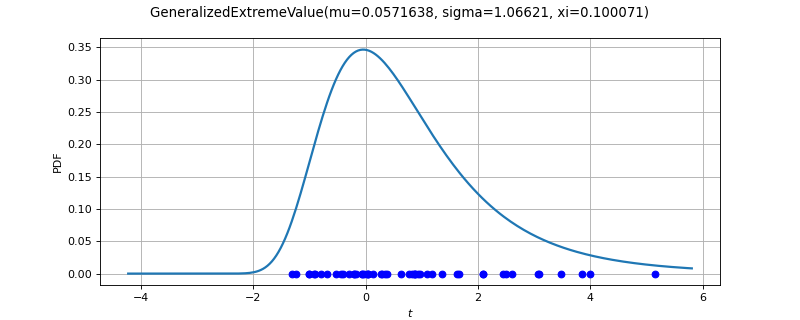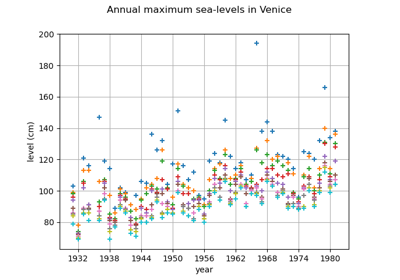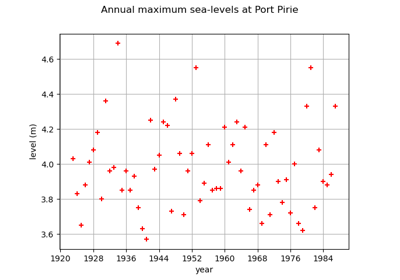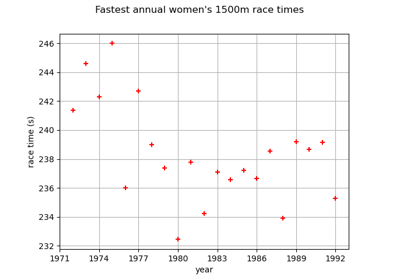GeneralizedExtremeValueFactory¶
(Source code, png)

- class GeneralizedExtremeValueFactory(*args)¶
GeneralizedExtremeValue factory.
See also
Notes
Several estimators to build a GeneralizedExtremeValueFactory distribution from a scalar sample are proposed. The details are given in the methods documentation.
The following
ResourceMapentries can be used to tweak the parameters of the optimization solver involved in the different estimators:GeneralizedExtremeValueFactory-DefaultOptimizationAlgorithm
GeneralizedExtremeValueFactory-MaximumEvaluationNumber
GeneralizedExtremeValueFactory-MaximumAbsoluteError
GeneralizedExtremeValueFactory-MaximumRelativeError
GeneralizedExtremeValueFactory-MaximumObjectiveError
GeneralizedExtremeValueFactory-MaximumConstraintError
GeneralizedExtremeValueFactory-InitializationMethod
GeneralizedExtremeValueFactory-NormalizationMethod
Methods
build(*args)Estimate the distribution via maximum likelihood.
Estimate the distribution as native distribution.
buildCovariates(*args)Estimate a GEV from covariates.
buildEstimator(*args)Build the distribution and the parameter distribution.
Estimate the distribution from the
largest order statistics.
Estimate the distribution and the parameter distribution with the R-maxima method.
buildMethodOfXiProfileLikelihood(sample[, r])Estimate the distribution with the profile likelihood.
Estimate the distribution and the parameter distribution with the profile likelihood.
buildReturnLevelEstimator(result, m)Estimate a return level and its distribution from the GEV parameters.
buildReturnLevelProfileLikelihood(sample, m)Estimate a return level and its distribution with the profile likelihood.
Estimate
and its distribution with the profile likelihood.
buildTimeVarying(*args)Estimate a non stationary GEV from a time-dependent parametric model.
Accessor to the bootstrap size.
Accessor to the object's name.
getName()Accessor to the object's name.
Accessor to the solver.
hasName()Test if the object is named.
setBootstrapSize(bootstrapSize)Accessor to the bootstrap size.
setName(name)Accessor to the object's name.
setOptimizationAlgorithm(solver)Accessor to the solver.
- __init__(*args)¶
- build(*args)¶
Estimate the distribution via maximum likelihood.
Available usages:
build(sample)
build(param)
- Parameters:
- sample2-d sequence of float
The block maxima sample of dimension 1 from which
are estimated.
- paramsequence of float
The parameters of the
GeneralizedExtremeValue.
- Returns:
- distribution
GeneralizedExtremeValue The estimated distribution.
- distribution
Notes
The estimation strategy described in
buildAsGeneralizedExtremeValue()is followed.
- buildAsGeneralizedExtremeValue(*args)¶
Estimate the distribution as native distribution.
Available usages:
buildAsGeneralizedExtremeValue()
buildAsGeneralizedExtremeValue(sample)
buildAsGeneralizedExtremeValue(param)
- Parameters:
- sample2-d sequence of float
The block maxima sample of dimension 1 from which
are estimated.
- paramsequence of float
The parameters of the
GeneralizedExtremeValue.
- Returns:
- distribution
GeneralizedExtremeValue The estimated distribution as a GeneralizedExtremeValue.
In the first usage, the default GeneralizedExtremeValue distribution is built.
- distribution
Notes
The estimate maximizes the log-likelihood of the model.
- buildCovariates(*args)¶
Estimate a GEV from covariates.
- Parameters:
- sample2-d sequence of float
The block maxima grouped in a sample of size
and one dimension.
- covariates2-d sequence of float
Covariates sample. A constant column is automatically added if it is not provided.
- muIndicessequence of int, optional
Indices of covariates considered for parameter
.
By default, an empty sequence.
The index of the constant covariate is added if empty or if the covariates do not initially contain a constant column.
- sigmaIndicessequence of int, optional
Indices of covariates considered for parameter
.
By default, an empty sequence.
The index of the constant covariate is added if empty or if the covariates do not initially contain a constant column.
- xiIndicessequence of int, optional
Indices of covariates considered for parameter
.
By default, an empty sequence.
The index of the constant covariate is added if empty or if the covariates do not initially contain a constant column.
- muLink
Function, optional The
function.
By default, the identity function.
- sigmaLink
Function, optional The
function.
By default, the identity function.
- xiLink
Function, optional The
function.
By default, the identity function.
- initializationMethodstr, optional
The initialization method for the optimization problem: Gumbel or Static.
By default, the method Gumbel (see
ResourceMap, key GeneralizedExtremeValueFactory-InitializationMethod).- normalizationMethodstr, optional
The data normalization method: CenterReduce, MinMax or None.
By default, the method MinMax (see
ResourceMap, key GeneralizedExtremeValueFactory-NormalizationMethod).
- Returns:
- result
CovariatesResult The result class.
- result
Notes
Let
be a GEV model whose parameters depend on
covariates denoted by
:
We denote by
the values of
associated to the values of the covariates
.
For numerical reasons, it is recommended to normalize the covariates. Each covariate
has its own normalization:
and with three ways of defining
of the covariate
:
the CenterReduce method where
is the covariate mean and
is the standard deviation of the covariates;
the MinMax method where
is the min value of the covariate
and
its range. This is the default method;
the None method where
and
: in that case, data are not normalized.
Let
be the vector of parameters. Then,
depends on all the
covariates even if each component of
only depends on a subset of the covariates. We denote by
the
covariates involved in the modelling of the component
.
Each component
can be written as a function of the normalized covariates:
This relation can be written as a function of the real covariates:
where:
is usually referred to as the inverse-link function of the component
,
each
.
To allow some parameters to remain constant, i.e. independent of the covariates (this will generally be the case for the parameter
), the library systematically adds the constant covariate to the specified covariates.
The complete vector of parameters is defined by:
where
.
The estimator of
maximizes the likelihood of the model which is defined by:
where
denotes the GEV density function with parameters
and evaluated at
.
Then, if none of the
is zero, the log-likelihood is defined by:
defined on
such that
for all
.
And if any of the
is equal to 0, the log-likelihood is defined as:
The initialization of the optimization problem is crucial. Two initial points
are proposed:
the Gumbel initial point: in that case, we assume that the GEV is a stationary Gumbel distribution and we deduce
from the mean
and standard variation
of the data:
and
where
is Euler’s constant; then we take the initial point
. This is the default initial point;
the Static initial point: in that case, we assume that the GEV is stationary and
is the maximum likelihood estimate resulting from that assumption.
The result class provides:
the estimator
,
the asymptotic distribution of
,
the parameter function
,
the graphs of the parameter functions
, where all the components of
are fixed to a reference value excepted for
, for each
,
the graphs of the parameter functions
, where all the components of
are fixed to a reference value excepted for
, for each
,
the normalizing function
,
the optimal log-likelihood value
,
the GEV distribution at covariate
,
the graphs of the quantile functions of order
:
where all the components of
are fixed to a reference value excepted for
, for each
,
the graphs of the quantile functions of order
:
where all the components of
are fixed to a reference value excepted for
, for each
.
- buildEstimator(*args)¶
Build the distribution and the parameter distribution.
- Parameters:
- sample2-d sequence of float
Data.
- parameters
DistributionParameters Optional, the parametrization.
- Returns:
- resDist
DistributionFactoryResult The results.
- resDist
Notes
According to the way the native parameters of the distribution are estimated, the parameters distribution differs:
Moments method: the asymptotic parameters distribution is normal and estimated by Bootstrap on the initial data;
Maximum likelihood method with a regular model: the asymptotic parameters distribution is normal and its covariance matrix is the inverse Fisher information matrix;
Other methods: the asymptotic parameters distribution is estimated by Bootstrap on the initial data and kernel fitting (see
KernelSmoothing).
If another set of parameters is specified, the native parameters distribution is first estimated and the new distribution is determined from it:
if the native parameters distribution is normal and the transformation regular at the estimated parameters values: the asymptotic parameters distribution is normal and its covariance matrix determined from the inverse Fisher information matrix of the native parameters and the transformation;
in the other cases, the asymptotic parameters distribution is estimated by Bootstrap on the initial data and kernel fitting.
- buildMethodOfLikelihoodMaximization(sample, r=0)¶
Estimate the distribution from the
largest order statistics.
- Parameters:
- sample2-d sequence of float
Block maxima grouped in a sample of size
and dimension
.
- rint,
,
Number of largest order statistics taken into account among the
stored ones.
By default,
which means that all the maxima are used.
- Returns:
- distribution
GeneralizedExtremeValue The estimated distribution.
- distribution
Notes
The method estimates a GEV distribution parameterized by
from a given sample.
Let us suppose we have a series of independent and identically distributed variables and that data are grouped into
blocks. In each block, the largest
observations are recorded.
We define the series
for
where the values are sorted in decreasing order.
The estimator of
maximizes the log-likelihood built from the
largest order statistics, with
defined as:
If
, then:
(1)¶
defined on
such that
for all
and
.
If
, then:
(2)¶
- buildMethodOfLikelihoodMaximizationEstimator(sample, r=0)¶
Estimate the distribution and the parameter distribution with the R-maxima method.
- Parameters:
- sampleM2-d sequence of float
Block maxima grouped in a sample of size
and dimension
.
- rint,
, optional
Number of order statistics taken into account among the
stored ones.
By default,
which means that all the maxima are used.
- Returns:
- result
DistributionFactoryLikelihoodResult The result class.
- result
Notes
The method estimates a GEV distribution parameterized by
from a given sample.
The estimator
is defined using the profile log-likelihood as detailed in
buildMethodOfLikelihoodMaximization().The result class produced by the method provides:
the GEV distribution associated to
,
the asymptotic distribution of
.
- buildMethodOfXiProfileLikelihood(sample, r=0)¶
Estimate the distribution with the profile likelihood.
- Parameters:
- sample2-d sequence of float
Block maxima grouped in a sample of size
and dimension
.
- rint,
,
Number of largest order statistics taken into account among the
stored ones.
By default,
which means that all the maxima are used.
- Returns:
- distribution
GeneralizedExtremeValue The estimated distribution.
- distribution
Notes
The method estimates a GEV distribution parameterized by
from a given sample.
The estimator
is defined using a nested numerical optimization of the log-likelihood:
where
is detailed in equations (1) and (2) with
.
If
then:
The starting point of the optimization is initialized from the probability weighted moments method, see [diebolt2008].
- buildMethodOfXiProfileLikelihoodEstimator(sample, r=0)¶
Estimate the distribution and the parameter distribution with the profile likelihood.
- Parameters:
- sample2-d sequence of float
Block maxima grouped in a sample of size
and dimension
.
- rint,
,
Number of largest order statistics taken into account among the
stored ones. The block maxima sample of dimension 1 from which
are estimated.
By default,
which means that all the maxima are used.
- Returns:
- result
ProfileLikelihoodResult The result class.
- result
Notes
The method estimates a GEV distribution parameterized by
from a given sample.
The estimator
is defined in
buildMethodOfXiProfileLikelihood().The result class produced by the method provides:
the GEV distribution associated to
,
the asymptotic distribution of
,
the profile log-likelihood function
,
the optimal profile log-likelihood value
,
confidence intervals of level
of
.
- buildReturnLevelEstimator(result, m)¶
Estimate a return level and its distribution from the GEV parameters.
- Parameters:
- result
DistributionFactoryResult Likelihood estimation result of a
GeneralizedExtremeValue- mfloat
The return period expressed in terms of number of blocks.
- result
- Returns:
- distribution
Distribution The asymptotic distribution of
.
- distribution
Notes
Let
be a random variable which follows a GEV distribution parameterized by
.
The
-block return level
is the level exceeded on average once every
blocks. The
-block return level can be translated into the annual-scale: if there are
blocks per year, then the
-year return level corresponds to the
-bock return level where
.
The
-block return level is defined as the quantile of order
of the GEV distribution:
If
:
(3)¶
If
:
(4)¶
The estimator
of
is deduced from the estimator
of
.
The asymptotic distribution of
is obtained by the Delta method from the asymptotic distribution of
. It is a normal distribution with mean
and variance:
where
and
is the asymptotic covariance of
.
- buildReturnLevelProfileLikelihood(sample, m)¶
Estimate a return level and its distribution with the profile likelihood.
- Parameters:
- sample2-d sequence of float
The block maxima sample of dimension 1.
- Returns:
- distribution
Normal The asymptotic distribution of
.
- distribution
Notes
Let
be a random variable which follows a GEV distribution parameterized by
.
The
-return level
is defined in
buildReturnLevelEstimator().The estimator is defined using a nested numerical optimization of the log-likelihood:
where
is the log-likelihood detailed in (1) and (2) with
and where we substitued
for
using equations (3) or (4).
The estimator
of
is defined by:
The asymptotic distribution of
is normal.
The starting point of the optimization is initialized from the regular maximum likelihood method.
- buildReturnLevelProfileLikelihoodEstimator(sample, m)¶
Estimate
and its distribution with the profile likelihood.
- Parameters:
- sample2-d sequence of float
The block maxima sample of dimension 1.
- mfloat
The return period expressed in terms of number of blocks.
- Returns:
- result
ProfileLikelihoodResult The result class.
- result
Notes
Let
be a random variable which follows a GEV distribution parameterized by
.
The
-block return level
is defined in
buildReturnLevelEstimator(). The profile log-likelihoodis defined in
buildReturnLevelProfileLikelihood().The estimator of
is defined by:
The result class produced by the method provides:
the GEV distribution associated to
,
the asymptotic distribution of
,
the profile log-likelihood function
,
the optimal profile log-likelihood value
,
confidence intervals of level
of
.
- buildTimeVarying(*args)¶
Estimate a non stationary GEV from a time-dependent parametric model.
- Parameters:
- sample2-d sequence of float
The block maxima grouped in a sample of size
and one dimension.
- timeStamps2-d sequence of float
Values of
.
- basis
Basis Functional basis respectively for
,
and
.
- muIndicessequence of int, optional
Indices of basis terms considered for parameter
- sigmaIndicessequence of int, optional
Indices of basis terms considered for parameter
- xiIndicessequence of int, optional
Indices of basis terms considered for parameter
- muLink
Function, optional The
function.
By default, the identity function.
- sigmaLink
Function, optional The
function.
By default, the identity function.
- xiLink
Function, optional The
function.
By default, the identity function.
- initializationMethodstr, optional
The initialization method for the optimization problem: Gumbel or Static.
By default, the method Gumbel (see
ResourceMap, key GeneralizedExtremeValueFactory-InitializationMethod).- normalizationMethodstr, optional
The data normalization method: CenterReduce, MinMax or None.
By default, the method MinMax (see
ResourceMap, key GeneralizedExtremeValueFactory-NormalizationMethod).
- Returns:
- result
TimeVaryingResult The result class.
- result
Notes
Let
be a non stationary GEV distribution:
We denote by
the values of
on the time stamps
.
For numerical reasons, it is recommended to normalize the time stamps. The following mapping is applied:
and with three ways of defining
:
the CenterReduce method where
is the mean time stamps and
is the standard deviation of the time stamps;
the MinMax method where
is the first time and
the range of the time stamps. This is the default method;
the None method where
and
: in that case, data are not normalized.
If we denote by
is a component of
, then
can be written as a function of
:
where:
is the size of the functional basis involved in the modelling of
,
is usually referred to as the inverse-link function of the parameter
,
each
is a scalar function
,
each
.
We denote by
,
and
the size of the functional basis of
,
and
respectively. We denote by
the complete vector of parameters.
The estimator of
maximizes the likelihood of the non stationary model which is defined by:
where
denotes the GEV density function with parameters
evaluated at
.
Then, if none of the
is zero, the log-likelihood is defined by:
defined on
such that
for all
.
And if any of the
is equal to 0, the log-likelihood is defined as:
The initialization of the optimization problem is crucial. Two initial points
are proposed:
the Gumbel initial point: in that case, we assume that the GEV is a stationary Gumbel distribution and we deduce
from the empirical mean
and the empirical standard variation
of the data:
and
where
is Euler’s constant; then we take the initial point
. This is the default initial point;
the Static initial point: in that case, we assume that the GEV is stationary and
is the maximum likelihood estimate resulting from that assumption.
The result class produced by the method provides:
the estimator
,
the asymptotic distribution of
,
the parameter functions
,
the normalizing function
,
the optimal log-likelihood value
,
the GEV distribution at time
,
the quantile functions of order
:
.
- getBootstrapSize()¶
Accessor to the bootstrap size.
- Returns:
- sizeint
Size of the bootstrap.
- getClassName()¶
Accessor to the object’s name.
- Returns:
- class_namestr
The object class name (object.__class__.__name__).
- getName()¶
Accessor to the object’s name.
- Returns:
- namestr
The name of the object.
- getOptimizationAlgorithm()¶
Accessor to the solver.
- Returns:
- solver
OptimizationAlgorithm The solver used for numerical optimization of the moments.
- solver
- hasName()¶
Test if the object is named.
- Returns:
- hasNamebool
True if the name is not empty.
- setBootstrapSize(bootstrapSize)¶
Accessor to the bootstrap size.
- Parameters:
- sizeint
The size of the bootstrap.
- setName(name)¶
Accessor to the object’s name.
- Parameters:
- namestr
The name of the object.
- setOptimizationAlgorithm(solver)¶
Accessor to the solver.
- Parameters:
- solver
OptimizationAlgorithm The solver used for numerical optimization of the moments.
- solver
 OpenTURNS
OpenTURNS




